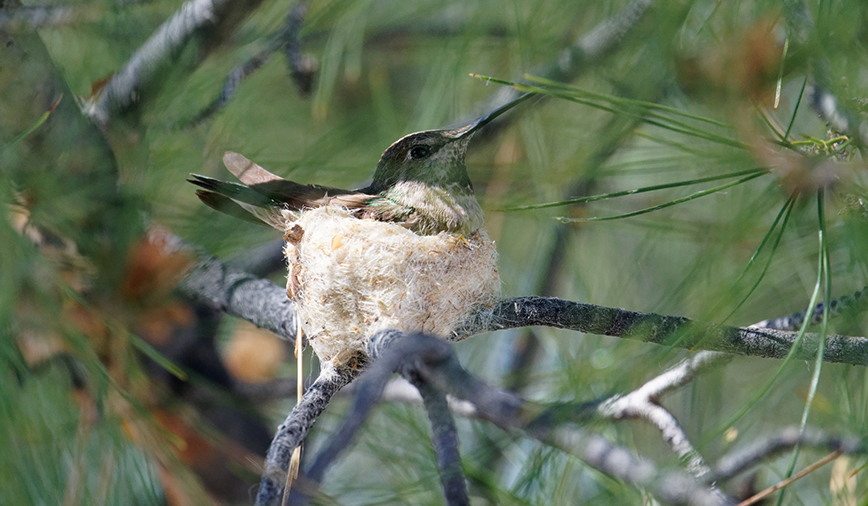February 27, 2015
Bird Tracks
Good Natured readers Stephanie Frisque and John Kowal of Batavia shared this photo of two young hummingbirds, alive and well, thanks to some quick thinking…and duct tape.
Mythbusters, the TV show that debunks rumors, legends and pseudo-scientific claims, once did an episode on the many uses of duct tape. To summarize their findings, host Jamie Hyneman remarked that “Duct tape is not a perfect solution for anything. But with a little ingenuity, in a pinch, it’s an adequate solution for just about everything.”
Including, it turns out, saving a family of hummingbirds. Just ask Stephanie Frisque and her husband John Kowal.
A few weeks ago the Batavia couple had some tree work done–a little trimming and pruning, nothing really out of the ordinary. At least that’s what they thought. But then one of the workers noticed a teeny tiny nest on one of the downed branches.
Stephanie said the structure was about as big as a sushi roll (which, for non sushi lovers, equates to about 2 in. across and maybe 1 in. deep), an absolutely exquisite creation of lichens and plant down held together with sticky spider silk.
As a place to raise a family, it had every quality a hummingbird could ask for. Except that it was lying on the ground–with two wee hummers inside.
Thankfully the tree trimmers acted quickly and moved the limb out of harm’s way. The question that loomed, though, was, “Now what?”
I don’t know if anybody on the scene that day watches Mythbusters or not, but it wasn’t long before they arrived at an “adequate” solution to this most puzzling predicament: Duct tape!
The crew hoisted the branch back up whence it came and taped it in place. The angle was a bit odd, but the magical adhesive held fast. Then, however, a new concern arose. What if the mom wouldn’t come back?
Stephanie says she never did see mom anywhere near the nest, and worried at first that their fears were confirmed. She even spent a fair amount of time wondering whether she should try and find a hummingbird rescuer to come out and intervene. But as the hours stretched into days, something became apparent: The little birds were doing just fine! Thriving, even, despite their rock-a-bye-baby-style introduction to the world.
A hummingbird mom (dad is off on his own by the time the kids arrive) feeds her nestlings a steady diet of insects—a protein-laden food source that even adult hummers consume. (Show of hands… Who thought those long, pointy bills were only used for sipping nectar?)
Visiting the nest one to three times each hour, the female wastes no time shuttling food to her brood. In fact, even while at the nest she typically just hovers before flying off again. This behavior not only makes for faster trips, but also serves to not draw attention to the well-concealed nest. Plus, it saves the bird from trying to perch using its weak legs and mini-feet. (Fun fact No.1: Hummingbirds belong to the order Apodiformes, which translates to “no feet.”
While that’s not exactly true—the feet are there, just much reduced—it does help explain the bird’s well-known habit of hovering. Chimney swifts, which don’t hover, but rather perch by hanging vertically, are another famous member of this group.)
Stephanie noticed that as the babies got bigger, the space within the nest grew tight. Then came the day when they weren’t in the nest at all, but rather out on the branch—still duct-taped to the tree–stretching their wings and preparing for their first flight. (Fun fact No. 2: Ruby-throated hummingbird wings flap at more than 50 beats per second.)
In another day they were gone—fledged and flying free. All that remained of the incident was the skewed nest, looking somewhat the worse for wear, tilting precariously on the duct-taped branch.
The take-away from Stephanie and John’s story is twofold. One, when left to their own devices, wild parents are perfectly capable of caring for their offspring, even when it seems like the odds are against them. The old baby wildlife adage, “If you care, leave them there,” applies in nearly every case, except those where the parents are clearly injured or deceased. Human knowledge is a poor substitute for animals’ instincts.
Two—the perhaps more obvious lesson—is that, like the Mythbusters found, duct tape really can fix just about everything.
Pam Erickson Otto is the manager of nature programs and interpretive services at the Hickory Knolls Discovery Center, a facility of the St. Charles Park District. She can be reached at 630-513-4346 or potto@stcparks.org.

